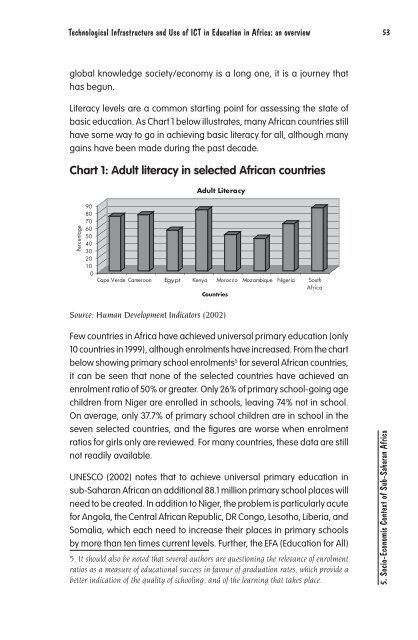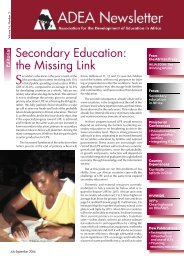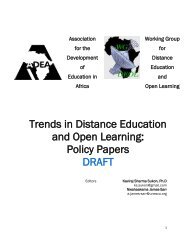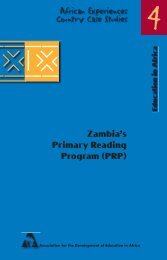Technological Infrastructure and Use of ICT in Education in ... - ADEA
Technological Infrastructure and Use of ICT in Education in ... - ADEA
Technological Infrastructure and Use of ICT in Education in ... - ADEA
You also want an ePaper? Increase the reach of your titles
YUMPU automatically turns print PDFs into web optimized ePapers that Google loves.
<strong>Technological</strong> <strong>Infrastructure</strong> <strong>and</strong> <strong>Use</strong> <strong>of</strong> <strong>ICT</strong> <strong>in</strong> <strong>Education</strong> <strong>in</strong> Africa: an overview<br />
53<br />
global knowledge society/economy is a long one, it is a journey that<br />
has begun.<br />
Literacy levels are a common start<strong>in</strong>g po<strong>in</strong>t for assess<strong>in</strong>g the state <strong>of</strong><br />
basic education. As Chart 1 below illustrates, many African countries still<br />
have some way to go <strong>in</strong> achiev<strong>in</strong>g basic literacy for all, although many<br />
ga<strong>in</strong>s have been made dur<strong>in</strong>g the past decade.<br />
Chart 1: Adult literacy <strong>in</strong> selected African countries<br />
<br />
<br />
<br />
<br />
<br />
<br />
<br />
<br />
<br />
<br />
<br />
<br />
<br />
<br />
<br />
Source: Human Development Indicators (2002)<br />
Few countries <strong>in</strong> Africa have achieved universal primary education (only<br />
10 countries <strong>in</strong> 1999), although enrolments have <strong>in</strong>creased. From the chart<br />
below show<strong>in</strong>g primary school enrolments 5 for several African countries,<br />
it can be seen that none <strong>of</strong> the selected countries have achieved an<br />
enrolment ratio <strong>of</strong> 50% or greater. Only 26% <strong>of</strong> primary school-go<strong>in</strong>g age<br />
children from Niger are enrolled <strong>in</strong> schools, leav<strong>in</strong>g 74% not <strong>in</strong> school.<br />
On average, only 37.7% <strong>of</strong> primary school children are <strong>in</strong> school <strong>in</strong> the<br />
seven selected countries, <strong>and</strong> the figures are worse when enrolment<br />
ratios for girls only are reviewed. For many countries, these data are still<br />
not readily available.<br />
UNESCO (2002) notes that to achieve universal primary education <strong>in</strong><br />
sub-Saharan African an additional 88.1 million primary school places will<br />
need to be created. In addition to Niger, the problem is particularly acute<br />
for Angola, the Central African Republic, DR Congo, Lesotho, Liberia, <strong>and</strong><br />
Somalia, which each need to <strong>in</strong>crease their places <strong>in</strong> primary schools<br />
by more than ten times current levels. Further, the EFA (<strong>Education</strong> for All)<br />
5. It should also be noted that several authors are question<strong>in</strong>g the relevance <strong>of</strong> enrolment<br />
ratios as a measure <strong>of</strong> educational success <strong>in</strong> favour <strong>of</strong> graduation rates, which provide a<br />
better <strong>in</strong>dication <strong>of</strong> the quality <strong>of</strong> school<strong>in</strong>g, <strong>and</strong> <strong>of</strong> the learn<strong>in</strong>g that takes place.<br />
5. Socio-Economic Context <strong>of</strong> Sub-Saharan Africa

















